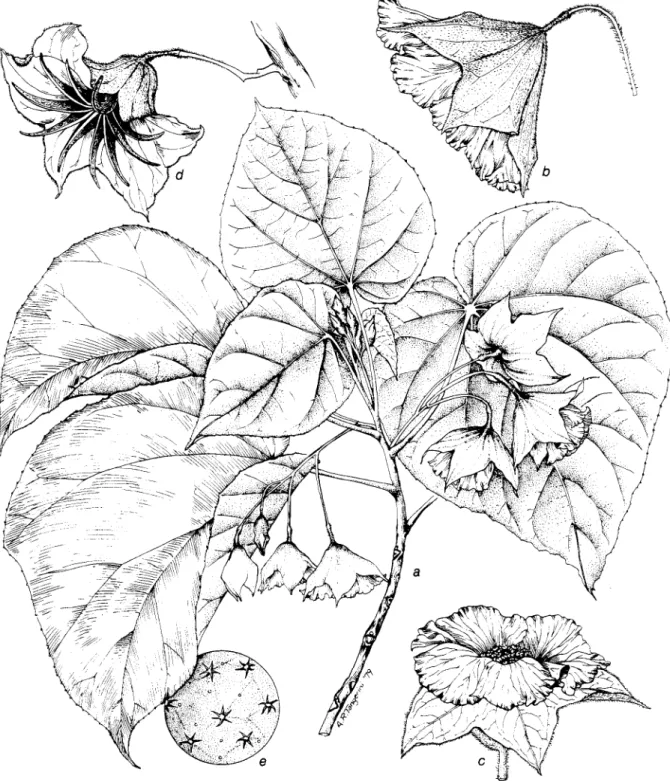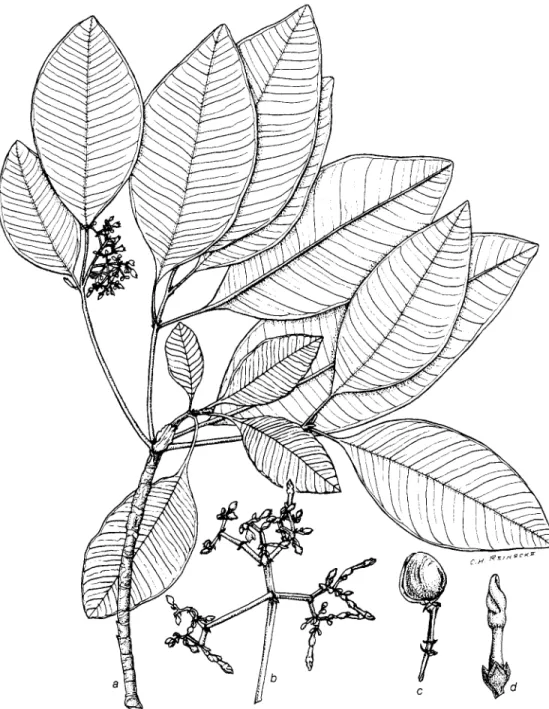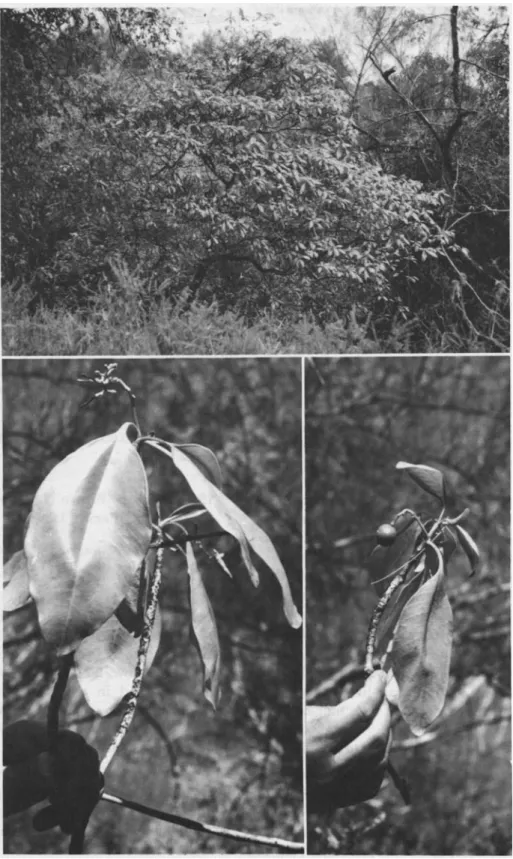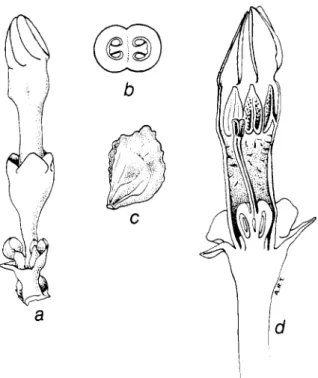A review of the available material of both genera in an excellent collection of US grasses. The specimens listed below are representative of the Pacific Island range of the species known to us. All other flowering collections had well-developed androecia and short peduncles, as in the species description above.

New Combinations in Zehneria Endlicher (Cucurbitaceae)
Tree, 1.5-18 m, 30 cm diameter, stems when young, dense and dense and irregular, minute stellate, with a few long hairs; leaves ovate to orbicular-cordate, apex acute, basal sinus narrow to overlapping, margins irregular, shallowly toothed, upper surface thinly encrusted with small stellate hairs and with scattered long simple hairs, under surface similar but much more densely stellate and with very long, simple hairs on nerves, 5 main nerves and 4 smaller ones from the base, pubescence of petiole similar to that of stems, petiole 5-6 cm long, blade up to 13 X 10 cm;. The leaf shape varies considerably, the type having them more conspicuously triangular than any of the other specimens seen. Large tree, leaves glabrous, young growth rust-serious glabrate, about 1 7 cm long, ovate to ovate, petiole short reddish hairy, teat, about 2.5 cm long; racemes in axils of the upper leaves, glabrous (usually almost imperceptibly puberulent or rarely sparsely strict towards the base), "spithamei" [a span of about 1 7 cm long]: flowers white, perianth-shaped, 5-parted , lobes ovate, acute, erect, crown none;.
Young growth rusty, heavy, leaves up to 22 X 1 1 cm almost glabrous, thin, obovate, hardly acuminate, pinnate at base in rather thin leaves 1-2 cm long, slender racemes , slightly heavy towards the base, almost glabrous distally with flowers, flowers rarely puber-. Tree up to 20 m tall, twigs brown or reddish brown, rooted, glabrate; leaves crowded towards the tips of the branches, up to 16 X 9 cm, ovate, ovate-. elliptic or rarely elliptic, above pilosulous on the costa towards the base, slightly pubescent below, veins 8-1 1 pairs; flowers white or pink in spikes 8-10 cm long, rachis tomentellous, distal staminate flowers, proximal hermaphrodite; calyx cup-shaped, 1 mm high, dense below, disc 5-lobed, 1.2 mm wide, filaments 1 mm long, style 1 mm long, fruit ellipsoid to ellipsoid-obovoid, slightly compressed, rounded narrow or compressed, 3.5-4 X 2.5-2.8 cm, glabrous. 15 mm long, 2-3 mm thick; spikes up to 13 cm long, rachis hirtellous-sericeous basally, becoming less so distally, terminal glabrous, flowers with ovules golden-sericeous, calyx very broadly campanulate, almost glabrous without, lobes triangular, in suffused with dense hairs, the stamens exserted from this, fruit ovoid, up to 4 X 3.5 X 2 cm, or mostly smaller, acute bicarinate, apex rather obtuse at the margin, base rounded, endocarp thick, corky, with 2 longitudinal grooves on each side.
Shrub or small tree, young parts yellowish downy; leaves obovate, glabrous or subglabrous, corroded, obovate, usually rounded, apex obtuse or truncate, base cuneate to subcordate, petiole subterete, about 1 cm or rarely up to 3 or even 4 cm long, hairy or pilosulous; His copy of "Terminalia!" is marked as from “Oporo Vainui” but may still be the specimen referred to and thus part of t Y Pe.
Further Notes on Myrsine L. (Myrsinaceae) in Eastern Polynesia
Gagne, whose 1977 collections provide a substantial addition to recorded knowledge of the Marquesan and Society Island floras. It is endemic to Fatuiva Island, Marquesas, where it appears to be very rare on high ridges. Low bushy shrubs, stems glabrous, internodes terete even when very young, 1.5-4.5 cm long, tuberous, leaves oblong-elliptic to ovate, glabrous, up to 9.5 X 5 cm, obtuse to acute or slightly acute at apex, acute to obtuse at base, 8 main veins on a side, petiole 7-14 m m long;.
SPECIMENS SEEN.-MARQUES ISLANDS: Fatuiva, Teavapuhiau Pass (above Ouia Valley), 785 m, Gagne 1247 (BISH, holotype; USA, isotype). It differs mainly in smaller, more elliptical leaves and lower triads of cymes, reduced to individual flowers. The sterile specimen from Hivaoa, Brown 1096 (BISH), cited with the original publication of Geniostoma hallei, probably belongs here.
Shrub or small tree, glabrous or rarely (1094/ . Cr) slightly puberulent, twigs somewhat but not strongly puberulent, internodes cm long, nodes rather prominent; leaves oblong to elliptic or rarely somewhat ovate, up to 9 X 4.5 cm, usually smaller, thin, venation rather obscure (except in 671/CZ, from Mangaia), main veins 5-7 on a side, subopposite to alternate, apex obtuse to rounded, petiole 2-6(-10) mm, rather slender, slightly puberulent; stippled collar thin, sides very low, rounded; inflorescences in middle leaf axils, rarely C I ) also on nodes below leaves, up to 15 mm long, glabrous, double or usually three times trichotomous or at lower nodes pentagonal, bracts ovate to ovate-lanceolate, subacuminate, carinate, margins and apical parts strongly papillate-puberulent; outer flowers in dichasium immediately covered by one or more bracts, and outer pedicels may have one or two bracts halfway up; sepals erect, separated almost to the base, narrowly triangular, strongly carinate, slightly acuminate, margins and acuity strongly papillate-pubemlent; corolla white, tube short, glabrous without, included in the calyx or somewhat extended, lobes ovate, deeply separated, usually somewhat clawed (or claws united into a tube in I017 b/CI) with 3 dark veins (when dry) the outer ones lumpy , papillae outside, especially towards the tip, strongly inside, the tips acurish; anthers ovate-triangular, sagittate at base, 0.8-1 mm long, style distinct, sharply set off from ovary, 1-1.5 mm long, slender, cylindrical-headed stigma, 0.5 mm long; fruit valves oblong 8. Large shrub or small tree, to 7 m tall, twigs slender, not or hardly square, internodes 1-3 cm long; vegetative parts smooth; leaves elliptic, at most 10 X 4 cm, usually 7-8 X 2.5-3 cm, thin, glossy above, light green, pointed at apex, pointed at base, main veins not very prominent, 5-8 on a side, subopposite to alternate, arching towards the margin, anastomosing and disappearing into an obscure network, petiole slender, 8-16 mm long; stippled collar low-triangular between petioles, quickly splitting and disintegrating; inflorescences, 10-14 mm long, puberulent, axillary or in nodes below the leaves, 1 or rarely 3 in a spike, twice trichotomous, rarely a n additional stalk outside each branch of the lower trichotomy, each lateral branch covered by a triangular somewhat compressed or carinated bract, each branch terminating in a triad or dicasium of pedicellate flowers, each lateral pedicel covered by a bract, each flower covered by a pair of bracts; sepals broadly triangular, tending to be slightly acuminate, puberulent, ciliolate, petals white or greenish, with a short tube, included in the calyx, lobes very broadly ovate, obtuse, smooth outside, with 3 broken slightly branched dark veins outside (when they are dry), ciliate, distal part within minutely but densely papillate-puberulent, basal part and neck conspicuously pilose;.
A New Rauvolfia L. (Apocynaceae) from the Marquesas3
The most unusual feature of this species is the shape and apparent behavior of the terminal parts of the inflorescence, which at first glance appear to be triads of flowers with the central flower pedicellate and the most developed, and the lateral ones sessile and much younger. , represented by spherical buds covered by a pair of scale-like bracts, the triad itself also covered by a pair of these. Triads with a central flower past anthesis or with it and its pedicel caducous have either rudimentary or developing triads with their own central pedicellate flowers. T h e inflorescence is constructed according to a plan of repeated trichotomies, with the central branch represented by a pedicled flower that forms a fruit or falls off.
In most other species of the studied genus, the ultimate cyme branches terminate in irregularly umbelloid clusters of pedicel flowers, which mature at different times.

Leucas R. Brown (Lamiaceae) in the Pacific Islands
Further examination of the original material of Cyrtandru jonesii (F. Brown) Gillett and of subsequent collections referred to this species suggests that two species are involved. It is difficult to ascertain which of the vegetative part of Brown's description is from which specimen except by reference to the specimens. His observations may well have been influenced by his idea that he was dealing with a member of the Campanulaceae.
The size of the leaves makes a huge difference, and the inflorescences are said to be born directly on the large branches, ie. This too has the lower surface of the leaves very thinly pubescent, rather glabrous, the margins irregularly toothed or toothed. This species is not uniform, it differs in the density of pubescence, the density of toothing of the leaf margins, the length of the petiole, the length and looseness of the inflorescence, and the width of the corolla.
This variety can be easily recognized by the surface of the leaves, especially smooth and soft. This is the commonest and most widespread of the Marquesan Cyrtandra species, found on Nukuhiva, Uahuka and Hivaoa, with most collections from the latter island. This species, according to ING is the type (lectotype) of the genus Dichrocephala L'Hdritier, although the author in brackets is wrongly given as Persoon, when it should be Desfontaines.
The following annotated synonyms are arranged chronologically by the first publication dates of the major early names involved.
Miscellaneous Taxonomic and Distributional Notes
This shows beyond any doubt that this species occurred in Tahiti in the pre-European period. Seemann's account of it from the Marquesas, with reference to a copy of Barclay, repeated by Drake, seems beyond doubt to be based on a misidentification of Barclay's copies of Adenostemma. It is said to have medicinal properties and is cultivated on several islands.
This appears to be the first authentic record of this species from the Pacific Islands east of the Ryukyus. In the Dominican Republic, West Indies, certain specimens of Vigna luteola (or as V. re- p e m ) have leaves much like those of V. One species of this genus, native to Tropical America, is planted in the Society Islands and the Marquesas.
Today it has replaced all other vegetation on certain slopes on the south side of the island, has spread everywhere in the wet valleys, and is proving to be a serious competitor for the native vegetation. This is the first record of it, and of the genus Mzconza, from the Pacific Islands.

